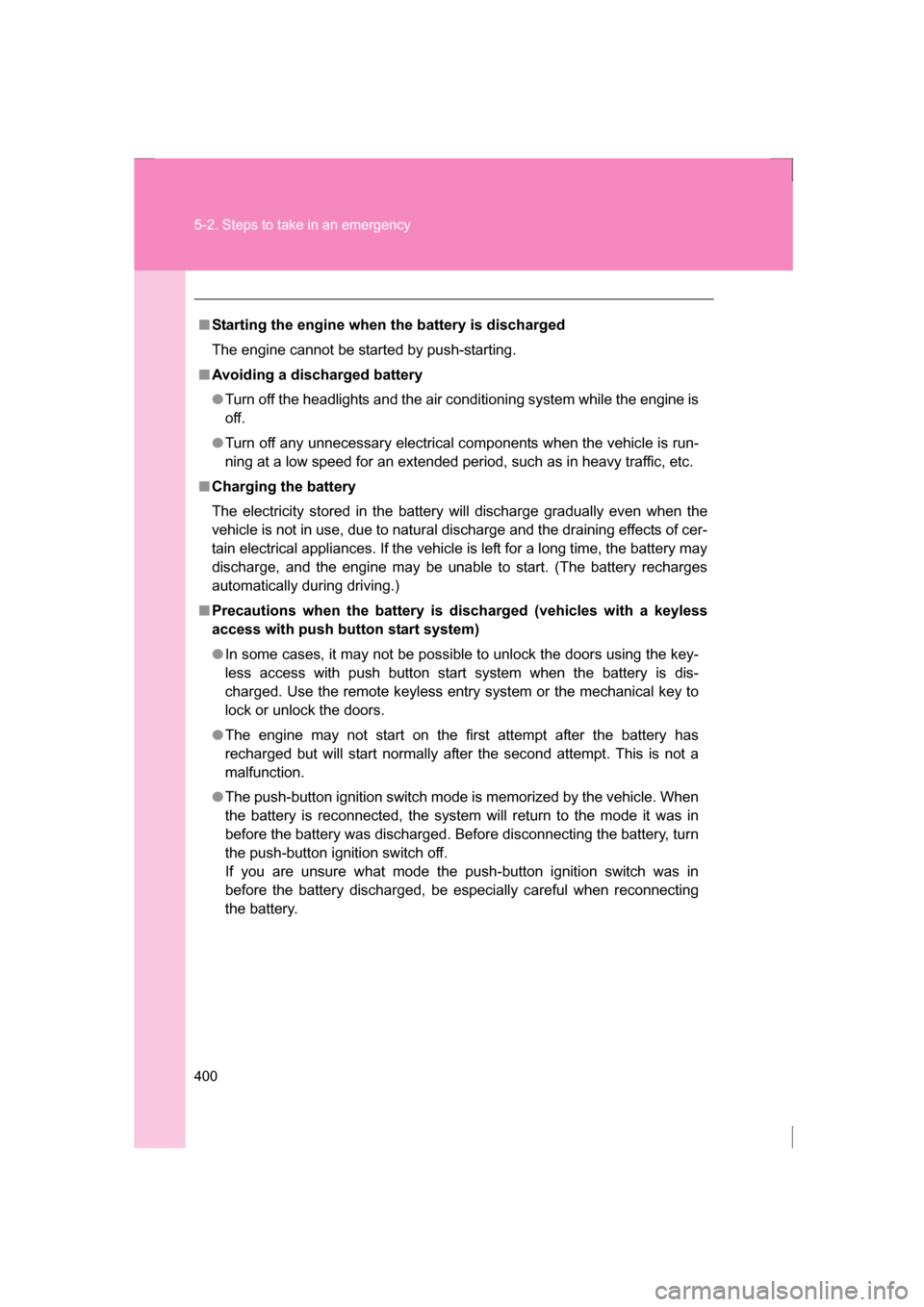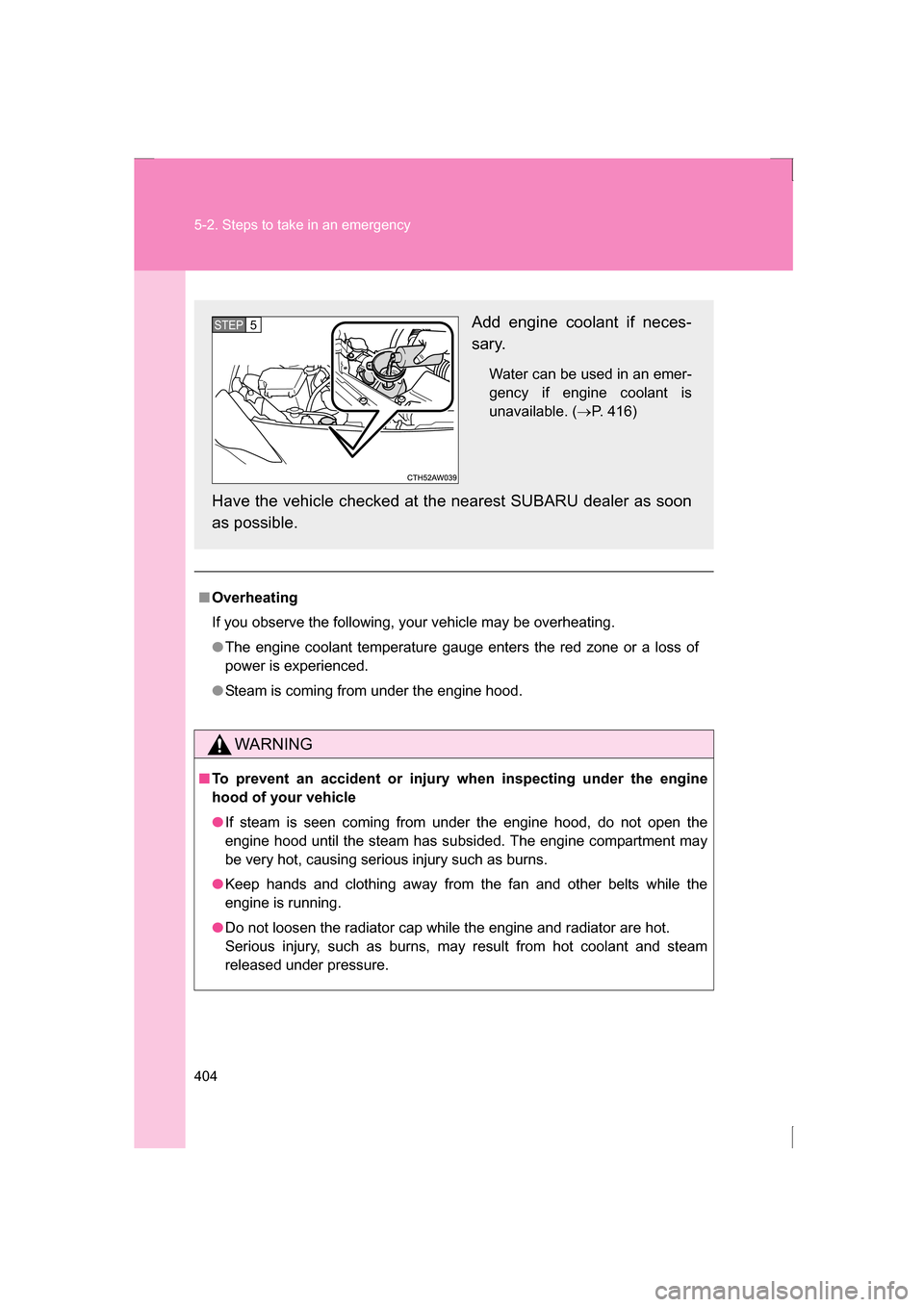Page 399 of 484
5
When trouble arises
399
5-2. Steps to take in an emergency
Vehicles without a keyless access with push button start
system: Maintain the engine speed of the second vehicle
and turn the engine switch to the “ON” position, then start
the vehicle's engine.
Vehicles with a keyless access with push button start sys-
tem: Maintain the engine speed of the second vehicle and
turn the push-button ignition switch to “ON” mode, then
start the vehicle's engine.
Once the vehicle’s engine has started, remove the jumper
cables in the exact reverse order in which they were con-
nected.
Once the engine starts, have the vehicle checked at your SUBARU
dealer as soon as possible.STEP 4
STEP 5
Page 400 of 484

400
5-2. Steps to take in an emergency
■Starting the engine when the battery is discharged
The engine cannot be started by push-starting.
■Avoiding a discharged battery
●Turn off the headlights and the air conditioning system while the engine is
off.
●Turn off any unnecessary electrical components when the vehicle is run-
ning at a low speed for an extended period, such as in heavy traffic, etc.
■Charging the battery
The electricity stored in the battery will discharge gradually even when the
vehicle is not in use, due to natural discharge and the draining effects of cer-
tain electrical appliances. If the vehicle is left for a long time, the battery may
discharge, and the engine may be unable to start. (The battery recharges
automatically during driving.)
■Precautions when the battery is discharged (vehicles with a keyless
access with push button start system)
●In some cases, it may not be possible to unlock the doors using the key-
less access with push button start system when the battery is dis-
charged. Use the remote keyless entry system or the mechanical key to
lock or unlock the doors.
●The engine may not start on the first attempt after the battery has
recharged but will start normally after the second attempt. This is not a
malfunction.
●The push-button ignition switch mode is memorized by the vehicle. When
the battery is reconnected, the system will return to the mode it was in
before the battery was discharged. Before disconnecting the battery, turn
the push-button ignition switch off.
If you are unsure what mode the push-button ignition switch was in
before the battery discharged, be especially careful when reconnecting
the battery.
Page 403 of 484
5
When trouble arises
403
5-2. Steps to take in an emergency
If your vehicle overheats
If your engine overheats:Stop the vehicle in a safe place and turn off the air condi-
tioning system.
Check to see if steam is coming out from under the engine
hood.
If you see steam:
Stop the engine. Carefully lift the engine hood after the
steam subsides and then restart the engine.
If you do not see steam:
Leave the engine running and carefully lift the engine hood.
Check to see if the cooling fan is operating.
If the fan is operating:
Wait until the temperature of the engine (shown on the
instrument cluster) begins to fall and then stop the engine.
If the fan is not operating:
Stop the engine and call your SUBARU dealer. After the engine has cooled
down sufficiently, check the
engine coolant level and
inspect the radiator core (radi-
ator) for any leaks.
STEP 1
STEP 2
STEP 3
STEP 4
Page 404 of 484

404
5-2. Steps to take in an emergency
■Overheating
If you observe the following, your vehicle may be overheating.
●The engine coolant temperature gauge enters the red zone or a loss of
power is experienced.
●Steam is coming from under the engine hood.
WARNING
■To prevent an accident or injury when inspecting under the engine
hood of your vehicle
●If steam is seen coming from under the engine hood, do not open the
engine hood until the steam has subsided. The engine compartment may
be very hot, causing serious injury such as burns.
●Keep hands and clothing away from the fan and other belts while the
engine is running.
●Do not loosen the radiator cap while the engine and radiator are hot.
Serious injury, such as burns, may result from hot coolant and steam
released under pressure.
Add engine coolant if neces-
sary.
Water can be used in an emer-
gency if engine coolant is
unavailable. ( →P. 416)
Have the vehicle checked at the nearest SUBARU dealer as soon
as possible.STEP 5
Page 405 of 484
5
When trouble arises
405
5-2. Steps to take in an emergency
CAUTION
■When adding engine coolant
Wait until the engine has cooled down before adding engine coolant.
When adding coolant, do so slowly. Adding cool coolant to a hot engine too
quickly can cause damage to the engine.
Page 406 of 484
406
5-2. Steps to take in an emergency
If the vehicle becomes stuck
■When it is difficult to free the vehicle
Carry out the following procedures
if the tires spin or the vehicle
becomes stuck in mud, dirt, or snow:
Stop the engine. Set the parking brake and shift the select
lever to P (vehicles with an automatic transmission) or shift
lever to neutral (vehicles with a manual transmission).
Remove the mud, snow or sand from around the rear
wheels.
Place wood, stones or some other material under the rear
wheels to help provide traction.
Restart the engine.
Shift the select lever to the D or R position (vehicles with an
automatic transmission) or shift lever to 1 or R position
(vehicles with a manual transmission) and release the park-
ing brake. Then, while exercising caution, depress the
accelerator pedal.
STEP 1
STEP 2
STEP 3
STEP 4
STEP 5
Press to turn off TRAC. ( →P. 216)
Page 412 of 484
412
6-1. Specifications
■Engine number
The engine number is stamped on the engine block as shown.
Page 413 of 484
413
6-1. Specifications
6
Vehicle specifications
Engine
Fuel
* : If unleaded gasoline with an octane rating of 93 AKI (98 RON) is not avail-
able, unleaded gasoline with an octane rating of 91 AKI (95 RON) may be
used with no detriment to engine durability or driveability.
Model FA20
Ty p e Horizontally opposed, liquid cooled 4 cylinder, 4-
stroke gasoline
Bore and stroke 3.4
× 3.4 in. (86 × 86 mm)
Displacement 121.9 cu.in. (1998 cm 3
)
Drive belt tension Automatic adjustment
Fuel type Unleaded gasoline only
Octane rating 93 AKI (98 RON) or higher*
Fuel tank capacity
(Reference) 13.2 gal. (50 L, 11.0 Imp. gal.)